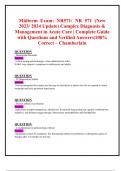Management in Acute Care | Complete Guide with Questions and Verified Answers |100% Correct – Chamberlain QUESTION Ipratropium Bromide Answer: A short -acting anticholinergic, when administered with a SABA, may improve symptoms in adolescents and adults. QUESTION IV Magnesium Sulfate Answer: Not recommended for routine use but may be beneficial in adults who fail to respond to initial treatment and have persistent hypoxemia. QUESTION Not for asthma exacerbation Answer: leukotriene receptor antagonists, inhaled cor - ticosteroid -long-acting beta agonist combinations, sedatives, and helium -oxygen therapy, Intravenous aminophylline and theophylline QUESTION Considerations in pulmonology referral Answer: inadequate control of symptoms. life -threatening asthma exacerbation, or therapeutic goals of therapy after 3 -6 months are not met Midterm Exam: NR571/ NR 571 (New 2023/ 2024 Update) Complex Diagnosis & QUESTION Follow -up after discharge of asthma exacerbation Answer: 72 hours to evaluate the efficacy of the prescribed treatment plan. QUESTION patient's role for asthma Answer: recognizing and control trigger exposures; taking and managing medications as prescribed; tracking symptoms and knowing when to seek treatment; seeking immediate treatment for worsening symptoms are the QUESTION provider's role for asthma Answer: prescribing and educating the patient on the proper administration of medication, developing a customized patient symptom monitoring and treatment plan; scheduling routine follow -up visits, and knowing when to refer the patient to a specialist for further management. QUESTION hallmark of COPD Answer: Extensive airway destruction is seen, in the advanced stages of QUESTION risk factors in COPD Answer: smoking( main reason), exposure to secondhand smoke, environmental irritants, occupational exposures, childhood pulmonary infections, HIV , genetic predisposition QUESTION respiratory infections Answer: COPD patients are also prone to frequent ?, and are the cause of acute exacerbation QUESTION COPD baseline symptoms Answer: exertional dyspnea, wheezing, chest tightness, fatigue, and chronic cough/ in (acute exacerbation), respiratory distress are s/s QUESTION Common complaints COPD exacerbation Answer: air hunger; increased cough; a change in color, viscosity, or amount of mucus; more noticeable wheezing than normal; dizziness or lightheadedness (due to hyperventilation and hypercapnia); worsened fatigue; trouble sleeping; headaches; severe anxiety, fea r, or sense of impending doom; chest tightness; and fever may be present. QUESTION Objective findings acute COPD exacerbation Answer: tachypnea, tachycardia, hy - poxia, hypercapnia, inspiratory and expiratory wheezing, decreased breath sounds due to limited airflow, acidosis may be present, which can lead to death QUESTION differentials for COPD Answer: pneumonia, upper respiratory tract infection, pul - monary emboli, reactive airway disease, congestive heart failure, pneumothorax, arrhythmias and myocardial infarction, upper airway obstruction, environmental irritants, dehydration resulting in thickened bronchial secretions are differentials QUESTION Diagnostic Testing for COPD Answer: history and physical exam, Chest x -ray(hyperin - flation and a flattened diaphragm), Labs, EKG, Spirometry are test QUESTION mild to moderate COPD exacerbation bronchodilator therapy Answer: long-acting B2 agonists (LABA), long -acting Antimuscarinic Agents (LAMA), inhaled corticos - teroids (ICS), systemic corticosteroids, antibiotics when signs of bacterial infection QUESTION COPD exacerbation needs emergency room Answer: severe worsening of dyspnea, hypoxia, altered mental status, new onset of cardiac symptoms, initial treatment has failed to respond, presence of serious comorbidities, inadequate home support, signs of acute respiratory failure QUESTION Emergency Room Treatment COPD acute exacerbations Answer: Oxygen (88 -92), SABA, Systemic Corticosteroids, Antibiotics,(ABG) -oxygenation, CO2 retention, and acidosis, treatment for QUESTION decision to discharge COPD acute exacerbations Answer: Is the patient in respi - ratory distress after treatment? Does the patient require continued supplemental oxygen? Is the patient hypercapnic despite treatment? if yes to any they need to stay QUESTION Secondary prevention strategies in COPD Answer:




